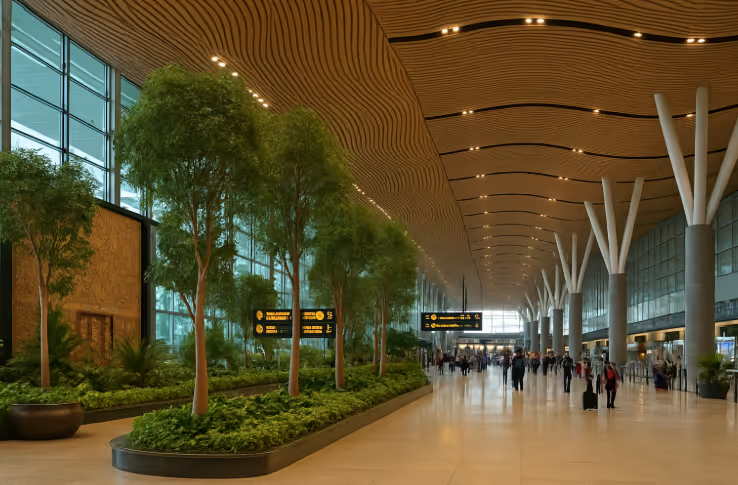Stay informed with our newsletter.
.webp)

.webp)

A Japanese vlogger's video showcasing Bengaluru's Kempegowda International Airport has gone viral, drawing global attention for its stunning architecture, eco-friendly design, and seamless passenger experience. The vlogger praised the terminal's lush greenery, Indian art, and sustainability features, calling it one of the best airports he has visited. The video has sparked widespread admiration online and highlighted India’s growing reputation for world-class infrastructure and innovative airport development.

In a digital age where travel influencers shape global perceptions, a recent video by a Japanese vlogger has gone viral, shining an unexpected yet flattering spotlight on India’s Kempegowda International Airport (KIA) in Bengaluru. The video, uploaded by popular Japanese content creator Yuta Tanaka, features a detailed walkthrough of Bengaluru Airport’s new Terminal 2 (T2), praising its stunning design, seamless passenger experience, and eco-friendly initiatives. Within days, the video garnered millions of views, trending across platforms like YouTube, X (formerly Twitter), and Instagram, and sparking global interest in India's rapidly transforming airport infrastructure.
This viral moment is more than just an influencer's commentary, it's a testament to how India’s aviation sector is gaining international recognition for innovation and sustainability. It also reinforces how soft power and design excellence can shape narratives, drawing admiration and tourism alike.
In his video titled “This is an Indian Airport? I’m Speechless!”, Yuta begins his vlog with an honest confession: he expected chaos, long lines, and minimal comfort at an Indian airport, a stereotype often attached to developing countries. However, what he found at Bengaluru’s T2 surprised him.
As the camera rolls, he takes viewers through the lush green interiors of the terminal, describing it as “walking into a forest rather than an airport.” His commentary is laced with awe as he points out intricate architectural details, wide open spaces filled with natural light, art installations inspired by Indian heritage, and the extensive use of sustainable materials. “I have travelled through Tokyo, Seoul, Singapore, and Amsterdam, but Bengaluru’s T2 is on another level,” he says.
What resonated most with audiences worldwide was not just the sleek aesthetics, but how Indian airports are reimagining public infrastructure with nature, culture, and passenger comfort at their core.
The new Terminal 2 at Kempegowda International Airport was officially inaugurated in November 2022 and began operations in January 2023. Dubbed the “Garden Terminal,” it was designed by American architectural firm SOM (Skidmore, Owings & Merrill) and developed by Bangalore International Airport Limited (BIAL).
T2 spans over 255,000 square meters and is designed to handle 25 million passengers annually. But what truly sets it apart is the blend of traditional Indian aesthetics with modern, sustainable architecture. Key features include:
For travelers like Yuta, it’s more than an airport, it’s an immersive cultural experience that begins the moment you land.
Following the viral video, several international media outlets and travel forums began spotlighting Bengaluru Airport. Travel bloggers from Europe and the Middle East reposted snippets, while prominent aviation analysts praised India’s strategic investment in passenger infrastructure. The Singapore-based portal Aviation Asia ran a feature titled “India’s Bengaluru Airport Sets a New Gold Standard in Terminal Design,” calling it a model for future airport construction.
The comments section of Yuta’s video is filled with viewers expressing surprise and admiration:
“Didn’t expect this from India, this airport looks better than JFK and LAX combined!”
“I’m booking my next layover in Bengaluru just to see this terminal.”
“Incredible to see how India is blending technology with tradition.”
Clearly, the airport has become more than a transit point, it’s a symbol of India’s ambition to stand shoulder-to-shoulder with global peers in infrastructure excellence.
Bengaluru Airport’s rise isn’t in isolation. India is in the midst of a massive airport development boom. The Union Government’s UDAN (Ude Desh ka Aam Nagrik) scheme and push for modern, green infrastructure have led to the construction and modernization of airports across tier-1 and tier-2 cities. By 2025, India is expected to have over 200 operational airports, compared to 153 in 2023.
Key highlights of this boom include:
All these airports focus heavily on sustainability, tech integration, and local cultural identity, aligning with the global shift towards eco-conscious travel.
Yuta Tanaka’s viral video highlights an often-overlooked aspect of national branding, how infrastructure can become a form of soft power. Airports are the first and last impression of a country for foreign travelers. By reimagining them as cultural and sustainable spaces, India is redefining how it’s perceived globally.
Unlike promotional tourism campaigns, these authentic moments, like a vlogger unexpectedly praising an Indian airport, have a deeper impact. They build trust, inspire curiosity, and shape public perception in ways that formal advertising cannot.
Moreover, this episode reflects the power of digital storytelling. A single video, shot with sincerity and curiosity, sparked a global conversation, showcasing India not just as a land of heritage, but as a future-ready nation investing in excellence.
Bengaluru’s Terminal 2 is not just an airport terminal; it’s a case study in visionary public infrastructure. From attracting praise from global travelers to being featured in design journals, it represents India’s evolving identity, one that is modern, sustainable, and rooted in culture.
The Japanese vlogger’s viral video has done more than entertain, it has inspired global audiences to re-evaluate India’s capabilities in design and planning. It is a reminder that international recognition often comes from unexpected quarters, and that investing in public spaces can yield reputational dividends.
As India continues to expand its aviation network and upgrade its airports, the world is watching, not just for its size, but for its soulful, sustainable, and smart approach to public infrastructure.
For questions or comments write to contactus@bostonbrandmedia.com
